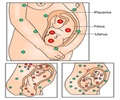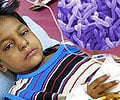Women born in India and Sri Lanka are three times more likely to suffer from extreme nausea and vomiting in pregnancy (hyperemesis gravidarum) than ethnic Norwegians, says a new study.
Women born in India and Sri Lanka are three times more likely to suffer from extreme nausea and vomiting in pregnancy (hyperemesis gravidarum) than ethnic Norwegians, says a new study.
The result was based on the finding that hyperemesis gravidarum varies among pregnant women from different countries.In the study, the data was collected from Norwegian Institute of Public Health's study of 900, 000 first-time pregnancies registered in the Medical Birth Registry of Norway over a forty year period.
Earlier studies reported that 90 percent of pregnant women experience some degree of nausea and vomiting, whereas 0.5 to 2 percent have hyperemesis gravidarum. Due to dehydration, loss of important electrolytes, malnutrition and weight loss, hyperemesis gravidarum could be life threatening for mother and baby if left untreated.
Ase Vikanes, specialist in gynaecology and obstetrics at the institute's Division of Epidemiology, wanted to explore whether the mothers' country of birth affected the prevalence of hyperemesis gravidarum
The research team collected data from the Medical Birth Registry of Norway, which since 1967 has recorded data on all pregnancies and pregnancy complications.
, 300 cases of hyperemesis gravidarum were recorded out of 900, 000 pregnancies, giving an overall prevalence of 0.89 percent. Data on the mother's country of birth and education were recorded by Statistics Norway and linked to pregnancy information through the mother's unique personal identification number. Socio-demographic factors such as marital status, country of birth, education, age and number of foetuses in each pregnancy were also studied.
Advertisement
Mothers born in India and Sri Lanka had the highest prevalence of hyperemesis gravidarum, followed by those born in Africa (excluding North Africa) and Pakistan by 3.2 percent, 3.1 percent and 2.1 percent, respectively.
Advertisement
Maternal age between 20-24 years old, being married, carrying a female foetus or more than one foetus were all socio-demographic characteristics associated with a higher prevalence of hyperemesis gravidarum.
"The difference in prevalence of hyperemesis gravidarum related to the mother's country of birth cannot be explained by differences in socio-demographic characteristics. We have to look for other explanations such as genetic factors, a change of diet or a history of infections. This topic needs further research to identify ways to prevent this life-threatening and distressing condition," Vikanes said.
The study "Variations in prevalence of hyperemesis gravidarum by country of birth: A study of 900, 074 pregnancies in Norway, 1967-2005" is published in Scandinavian Journal of Public Health.
Source-ANI
SRM/M











